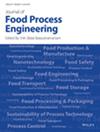Determination of Time Required for 5 Log Reduction of Foodborne Pathogens by High Hydrostatic Pressure Processing in Foods
Abstract
High hydrostatic pressure (HHP) is a nonthermal preservation technology for inactivating foodborne pathogens and spoilage organisms. The commercial use of HHP is generally performed at pressures of 400–600 MPa, at ambient initial temperature for less than 6 min. Moreover, at least 5 log10 reduction of target pathogen is required for safe HHP-treated foods. Literature data of foodborne pathogens (Escherichia coli, Listeria monocytogenes, Salmonella spp., etc.) were collected based on these ranges and information (P: 400–600 MPa, T: 4°C–25°C, t ≤ 6 min) and were described by the reparameterized Weibull model to find times required for 5 log10 of target pathogens together with their confidence limits. Results indicated that pressure values of even 400–450 MPa were sufficient to obtain 5 log10 reduction for times ≤ 6 min for high acid foods. Furthermore, 600 MPa treatment, which is generally used by the industry, is a robust and efficient application as holding times less than 5 min were generally enough to obtain 5 log10 reduction for most of the pathogens. Nevertheless, for some pathogens in milk, such as E. coli and Stapylococcus aureus, higher holding times of > 10 min were necessary which was not practical for a commercial HHP application. Conditions for microbial HHP studies generally do not match with industrial HHP applications. However, data selection criteria in this study were based on commercial applications. Information provided in this study would be beneficial for researchers as well as for HHP food processors for designing future studies and HHP treatments.

 求助内容:
求助内容: 应助结果提醒方式:
应助结果提醒方式:


